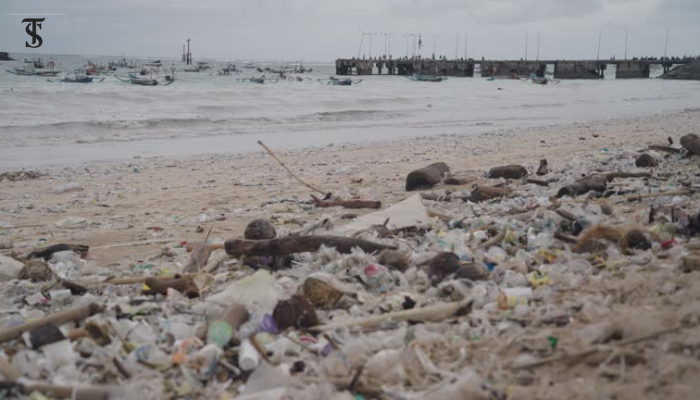Microplastics: The Invisible Threat to Our Health and Environment

- Health and Environmental Risks – Microplastics infiltrate the human body through food, water, and air, leading to severe health issues such as hormonal imbalances, infertility, and respiratory diseases. They also threaten marine life and ecosystems.
- Sources and Spread – Microplastics originate from plastic degradation, personal care products, and industrial waste, contaminating oceans, soil, and even clouds.
- Mitigation Strategies – Reducing plastic use, opting for sustainable alternatives, improving waste management, and enforcing stricter regulations are essential to combat microplastic pollution.
Microplastics are pervasive in our environment, found in the water we drink, the air we breathe, food packaging, and even our clothing. On average, individuals ingest approximately 5 grams of plastic per week—equivalent to consuming a credit card. The scale of health and environmental hazards caused by microplastics is alarming, as plastic has become an integral part of everyday life, including personal hygiene products. The urgent need to address this issue stems from the widespread use of plastic, which poses severe risks worldwide.
Plastic debris, regardless of its shape or size, harms the environment. Microplastics—fragments smaller than 5 mm—are particularly hazardous as they result from plastic pollution and are present in numerous daily-use products. Landfills significantly contribute to the disintegration of plastic into microplastics due to biochemical reactions, including temperature fluctuations, high salinity, low pH, and methane gas production. Research indicates that Maldives beaches have the highest plastic concentration globally, with approximately 280 million tonnes of plastic entering oceans annually.
Microplastics infiltrate the human body through ingestion, inhalation, and dermal exposure. Primary microplastics, such as exfoliating beads in skincare products and toothpaste, are intentionally manufactured in small sizes. Once inside the body, they accumulate in tissues, potentially leading to severe health issues. Secondary microplastics result from the breakdown of larger plastic waste through exposure to sunlight, water, soil, marine life, and atmospheric conditions.
Microplastic contamination affects various aspects of human existence, including food sources like seafood, salt, sugar, honey, bottled and tap water, and even the air. The pollution of soil and water is exacerbated in developing nations due to inadequate waste management systems. Microplastic pollution is a tangible and urgent threat, particularly in coastal areas reliant on marine life. Marine animals unknowingly consume microplastics, which subsequently enter the food chain, endangering human health.
Plastics take centuries to decompose, causing long-term environmental devastation. Even on beaches, microplastics appear as tiny, colorful fragments embedded in the sand. Studies reveal that plastic bottles release microplastics into drinking water, with bottled water containing significantly higher levels than tap water. These microplastics compromise the immune and digestive systems. When plastic bottles are squeezed, they develop visible white lines—evidence of microplastic shedding. The presence of microplastics in daily-use products is far more extensive than currently known, highlighting the urgent need to reduce plastic consumption on a large scale.
Personal care products, including toothpaste and scrubs, often contain microplastics. Consumers can minimise exposure by reading labels and opting for natural exfoliants like sugar and oats. Harmful chemicals such as polyethylene (PE), polypropylene (PP), bisphenol A (BPA), phthalates, and polycyclic aromatic hydrocarbons (PAHs) are common in microplastics and should be avoided. Studies suggest that these particles accumulate in organs, including the brain, blood, and breast milk, and may even induce behavioural changes. Researchers have detected microplastics in clouds, raising concerns about their potential effects on climate regulation.
Recent studies found microplastics in human testicles, raising alarm about their potential link to declining sperm counts. Microplastic exposure is increasingly associated with diabetes, infertility, cancer, obesity, metabolic disorders, and digestive diseases. Additionally, their inhalation can cause respiratory distress, lung damage, inflammation, and oxidative stress. Over time, microplastics may contribute to endocrine disruption, hormonal imbalances, reproductive issues, and foetal development complications.
To mitigate microplastic pollution, individuals should reduce plastic usage by opting for reusable materials like cloth bags, glass, or metal containers, and natural-fibre clothing. Reverse osmosis filtration can help reduce microplastic contamination in drinking water, although no filter can eliminate them. Choosing filtered water over bottled water, storing food in glass or metal containers, and avoiding heating food in plastic packaging can also help limit exposure. Processed foods may contain microplastics from packaging, making unpackaged or microbead-free options preferable.
Reducing airborne microplastic exposure involves proper ventilation, dusting, and regular cleaning. Replacing plastic with sustainable alternatives such as glass, wood, ceramic, and stainless steel is crucial. Consuming sulfur-rich foods (e.g., cruciferous vegetables) and antioxidants (e.g., berries) can aid in detoxification. Sweating through exercise, sauna use, and physical activity promotes the elimination of microplastics from the body. Microfiber filters are essential for capturing synthetic microfibers from laundry wastewater.
Governments can play a significant role in combating microplastic pollution by restricting single-use plastics, enforcing waste management regulations, monitoring plastic additives, and developing policies to mitigate exposure risks. Increased public awareness can drive eco-conscious consumer choices, fostering pollution prevention and sustainable environmental practices. Addressing microplastic pollution is imperative for global health and environmental sustainability.
The views and opinions expressed in this article/paper are the author’s own and do not necessarily reflect the editorial position of The Spine Times.

Quraitulain Qureshi
The author is a columnist and a CSS mentor.





